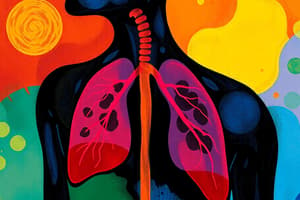Podcast
Questions and Answers
कोशिकाई श्वसन क्रिया के दौरान क्या उत्पन्न होता है?
कोशिकाई श्वसन क्रिया के दौरान क्या उत्पन्न होता है?
- एडेनोसीन ट्राइफ़ॉस्फेट (ATP) (correct)
- नैड और फ़ेडएच 2
- कार्बन डाइऑक्साइड
- प्य्रुवेट
कोशिकाई श्वसन क्रिया में 'ग्लाइकोलिसिस' का क्या महत्व होता है?
कोशिकाई श्वसन क्रिया में 'ग्लाइकोलिसिस' का क्या महत्व होता है?
- कार्बन डाइऑक्साइड पैदा करना
- पाइरुवेट उत्पन्न करना
- ATP मोलेक्यूल उत्पन्न करना (correct)
- NADH मोलेक्यूल उत्पन्न करना
कोशिकाई श्वसन क्रिया के कौन-से चरण में 'सिट्रिक एसिड साइकिल' होता है?
कोशिकाई श्वसन क्रिया के कौन-से चरण में 'सिट्रिक एसिड साइकिल' होता है?
- चौथे
- पहले
- दूसरे
- तीसरे (correct)
कोशिकाओं में 'प्रकाश संश्लेषण' के दौरान किस प्रकार की प्रक्रिया होती है?
कोशिकाओं में 'प्रकाश संश्लेषण' के दौरान किस प्रकार की प्रक्रिया होती है?
घरेलू प्रणाली को किसे कहा जाता है?
घरेलू प्रणाली को किसे कहा जाता है?
मिटोसिस प्रक्रिया क्या करती है?
मिटोसिस प्रक्रिया क्या करती है?
कौन-सा प्रकार के सेल् पर मेयोसिस प्रक्रिया होती है?
कौन-सा प्रकार के सेल् पर मेयोसिस प्रक्रिया होती है?
पादपों के कौन-से अंग में प्रकाश-संवेगी प्रतिक्रियाएँ होती हैं?
पादपों के कौन-से अंग में प्रकाश-संवेगी प्रतिक्रियाएँ होती हैं?
निम्नलिखित में से कौन सही है?
निम्नलिखित में से कौन सही है?
प्रमुख नियंत्रक प्रणाली को संतुलित रखने में कौन-सा प्रमुख सहायकी समुचित है?
प्रमुख नियंत्रक प्रणाली को संतुलित रखने में कौन-सा प्रमुख सहायकी समुचित है?
Flashcards are hidden until you start studying
Study Notes
Title: Unraveling Live Processes: Cellular Respiration, Homeostasis, Cell Division, Photosynthesis, and Metabolism
Introduction
In the intricate world of life, a host of fundamental processes keep living organisms thriving. Among these vital forces, we find cellular respiration, homeostasis, cell division, photosynthesis, and metabolism. This article will unravel the fascinating complexities of these live processes, exploring how they are interconnected and how they contribute to the preservation and sustenance of living organisms.
Cellular Respiration: The Energy Factory
Cellular respiration is the biochemical process by which cells generate energy in the form of adenosine triphosphate (ATP) from the chemical bonds of organic molecules. This process can be divided into three main stages: glycolysis, the citric acid cycle (also known as the Krebs cycle or TCA cycle), and oxidative phosphorylation.
During glycolysis, glucose molecules are broken down to produce pyruvate, generating a net gain of 2 ATP molecules and 2 NADH molecules (a high-energy electron carrier). The citric acid cycle further oxidizes pyruvate into carbon dioxide and water, yielding NADH and FADH2 (another high-energy electron carrier). Lastly, oxidative phosphorylation uses these electron carriers to produce ATP through the action of the electron transport chain and chemiosmosis.
Homeostasis: The Body's Balancing Act
Homeostasis refers to the ability of living organisms to maintain a stable internal environment despite external fluctuations. Key regulatory systems that help maintain homeostasis include the nervous system, endocrine system, and immune system.
For instance, the endocrine system secretes hormones that regulate vital physiological processes such as growth, metabolism, and reproduction. The nervous system is responsible for sending and processing signals that control movement, sensation, and the body's response to external stimuli. Meanwhile, the immune system protects the body against invading pathogens, keeping it healthy and free from infections.
Cell Division: The Replication of Life
Cell division is a process that generates new cells from existing ones. There are two main types of cell division: mitosis and meiosis.
Mitosis is the process by which a parent cell divides and forms two identical daughter cells, each containing the same number of chromosomes. This process is crucial for growth, repair, and asexual reproduction. Meiosis, on the other hand, is a specialized type of cell division that occurs in sex cells (sperm and eggs). During meiosis, the number of chromosomes is reduced by half, allowing for genetic variation in offspring.
Photosynthesis: The Sun's Energy Conversion
Photosynthesis is the process by which green plants and some other organisms use sunlight to convert carbon dioxide and water into glucose and oxygen. This biochemical process occurs in the chloroplasts of plant cells, where pigments such as chlorophyll absorb light energy.
Photosynthesis can be divided into two stages: light-dependent reactions and light-independent reactions (also known as the Calvin cycle). In the light-dependent reactions, light energy is absorbed and converted into chemical energy in the form of ATP and NADPH molecules. In the Calvin cycle, these energy-rich molecules are used to fix carbon dioxide into glucose, which can be used as an energy source by the plant.
Metabolism: The Life Processes' Engine
Metabolism is the sum of all the physical and chemical processes that occur within a living organism. These processes involve the conversion of nutrients into energy and the synthesis of essential biomolecules.
Metabolism can be divided into two main categories: anabolism (the synthesis of complex molecules from simpler ones) and catabolism (the breakdown of complex molecules into simpler ones). Cellular respiration, photosynthesis, and homeostasis are all metabolic processes that contribute to the overall energy balance of living organisms.
Conclusion
Live processes such as cellular respiration, homeostasis, cell division, photosynthesis, and metabolism are essential for sustaining life. They are interconnected systems that maintain the balance between energy production and consumption, help organisms maintain their internal environment, and facilitate growth and reproduction.
Understanding these processes allows us to appreciate the intricacies of life and to explore their potential applications in biotechnology, medicine, and environmental science. With this knowledge, we can better safeguard our world and the living organisms that inhabit it.
Studying That Suits You
Use AI to generate personalized quizzes and flashcards to suit your learning preferences.




